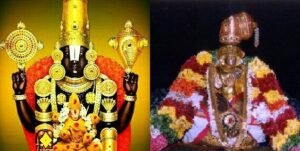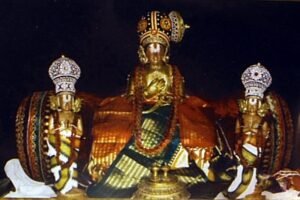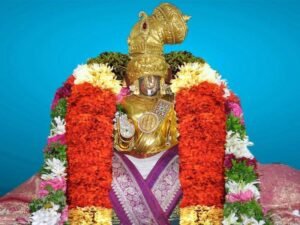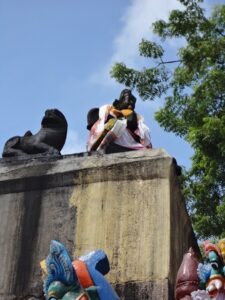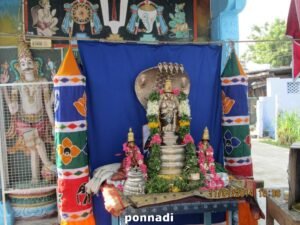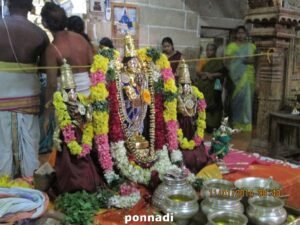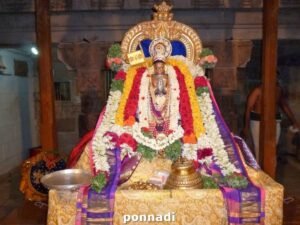SrI: SrImathE SatakOpAya nama: SrImathE rAmAnujAya nama: SrImath varavaramunayE nama: SrI vAnAchala mahAmunayE nama:
History
The temple in this dhivya dhEsam is famously known as AdhinAthar/AzhwAr dhEvasthAnam. This town is situated on the banks of the sacred thAmirabharaNi river. Our pUrvAchAryas explain that just like akAram (paramAthmA) and makAram (jIvAthmA) has equal importance in praNavam (OmkAram), here in this dhivya dhEsam, both perumAL and AzhwAr has equal importance. This dhivya dhEsam was originally known as thirukkurugUr. This is the avathAra sthalam (place of birth) for nammAzhwAr. After nammAzhwAr‘s birth, this dhivya dhEsam becomes to be famously known as AzhwAr thirunagari. This dhivya dhEsam is also part of navathiruppathi (9 temples around AzhwAr thirunagari which were sung by nammAzhwAr).
nammAzhwAr has performed mangaLAsAsanam (glorifications in pAsurams) to Adhi nAthan (mUlavar) and polindhu ninRa pirAn (uthsavar) of this dhivya dhEsam in his thiruvAimozhi. Glorifications of nammAzhwAr by various personalities – http://kaarimaaran.com/songs.html. nammAzhwAr’s 32 names displayed in thirukkurugUr (AzhwAr thirunagari) Temple. Tamil and English
In his first prabhandham itself (thiruviruththam), nammAzhwAr shows his divine attachment for varAha perumAL. In the 99th pAsuram, he declares that there is nothing more auspicious than gyAnappirAn (varAha perumAL) who rescued bhUmi pirAtti. Here in this dhivya dhEsam, there is a separate sannidhi for gyAnappirAn emperumAn with sannidhi garudAzhwAr.
nammAzhwAr‘s love and attachment towards thiruvEngadamudaiyAn (SrInivAsa) is immeasurable. To reciprocate AzhwAr’s devotion, SrInivAsan emperumAn descended himself in to 4 sannidhis (each in one direction).
- There is a thiruvEngadamudaiyAn sannidhi inside the AdhinAthar/AzhwAr temple – in the east side.
- There is a thiruvEngadamudaiyAn sannidhi in the south mAda street (street around the temple) – in the south side.
- There is a thiruvEngadamudaiyAn sannidhi inside the bhavishyadhAchAryan sannidhi – in the west side.
- There is a thiruvEngadamudaiyAn sannidhi in the north car street (main road) – in the north side.
During the life time of nammAzhwAr, madhurakavi AzhwAr was travelling in northern part of bhAratha dhEsam. Seeing the effulgence of nammAzhwAr in the form of a shining star from ayOdhyA (where he was residing), he visits AzhwAr thirunagari and meets nammAzhwAr who was staying in the thiruppuLi AzhwAr (tamarind tree) and becomes his sishya. madhurakavi AzhwAr compiles kaNNinuN chiRu thAmbu in glorification of nammAzhwAr and spreads the glories of nammAzhwAr far and wide. While nammAzhwAr was preparing to ascend to paramapadham, madhurakavi AzhwAr prays to nammAzhwAr to present him with an archA vigraham for his continuous worship. nammAzhwAr instructs madhurakavi AzhwAr to boil the water from thAmirabharaNi river and tells him that he will get an archA vigraham from that. When madhurakavi AzhwAr boils the water as instructed, he gets an archA vigraham with thridhaNdam (the three sticks carried by sannyAsis) and anjali hastham (hands held together in worshipping posture). madhurakavi AzhwAr being amazed by that, tells nammAzhwAr that he was expecting the archA vigraham with upadhEsa hastham (in a posture of giving instructions). nammAzhwAr tells madhurakavi AzhwAr that the vigraham arrived is the one of bhavishyadhAchAryan (the AchArya of future – SrI rAmanuja) who will appear about 4000 years later who will uplift every one. He instructs madhurakavi AzhwAr to boil the water again and after madhurakavi AzhwAr doing so, he gets another vigraham which resembles nammAzhwAr. This archA vigraham was then established at the Adhi nAthan emperumAn’s temple. bhavishyadhAchAryan archA vigraham was buried under the divine tamarind tree safely to be revealed in the future at the appropriate time.
nammAzhwAr, madhurakavi AzhwAr, nAthamunigaL (picture from kAnchIpuram)
azhagiya maNavALa perumAL nAyanAr, in his AchArya hrudhayam chUrNIkai 161, explains the divine emotions of nammAzhwAr towards this emperumAn. He explains that emperumAn‘s parathvam (supremacy) is most beautifully revealed in this wonderful dhivya dhEsam which has equal importance for Adhi nAthan emperumAn and nammAzhwAr.
Subsequently, nAthamunigaL visits AzhwAr thirunagari, hearing about nammAzhwAr and his thiruvAimozhi. He meditates on nammAzhwAr and recites kaNNinuN chiRu thAmbu 12000 times. Being pleased with nAthamunigaL‘s dedication and devotion, nammAzhwAr appears in front of him and teaches him all the 4000 dhivya prabhandham and their meaning. nAthamunigaL subsequently establishes the temple worship, recital methodology, etc. He divides 4000 dhivya prabhandham in to 4 parts and adds music wherever appropriate. He also teaches dhivya prabhandham with music to many of his sishyas and establishes the arayar sEvai (the practice of singing dhivya prabhandham with cymbals and action).
After some time, emperumAnAr visits AzhwAr thirunagari and performs mangaLAsAsanam to polindhu ninRa pirAn emperumAn and nammAzhwAr. He also visits navathiruppathi dhivya dhEsams. There are nice incidents identified in relation to emperumAnAr‘s visit to AzhwAr thirunagari and other near by dhivya dhEsams. When emperumAnAr performs mangaLAsAsanam to nammAzhwAr, AzhwAr being greatly delighted by emperumAnAr‘s devotion, gives a divine order “Hereafter my thiruvadi (lotus feet) will be known as ‘SrI rAmAnujam’ in AzhwAr thirunagari”. Usually his lotus feet is called “madhurakavigaL” every where. But in AzhwAr thirunagari alone, it is called as “SrI rAmAnujam” following nammAzhwAr‘s own orders.
As time passed, islamic invaders attacked various dhivya dhEsams in the southern region. Fearing imminent attack, AzhwAr was carried to kEraLa region where namperumAL was also present (travelling for the same reasons to avoid the attackers in SrIrangam). AzhwAr thirunagari becomes forested as people abandon the area after AzhwAr leaving the temple. thirumalai AzhwAr (thiruvAimozhi piLLai – SrI sailEsar) who is a dear sishya of piLLai lOkAchAryar and was the minister in the kingdom ruling that region, puts in great effort in bringing AzhwAr back to AzhwAr thirunagari. He locates AzhwAr thirunagari, clears the forest, re-builds the temple back to its true glories and re-establishes the temple norms. He also locates the bhavishyadhAchAyan vigraham and establishes a separate temple for bhavishyadhAchAryan (emperumAnAr) in the western part of the town. thiruvAimozhi piLLai stays at AzhwAr thirunagari and constantly engages in serving nammAzhwAr and emperumAnAr for the rest of his life.
 nammAzhwAr, emperumAnAr, piLLai lOkAchAryar, thiruvAimozhi piLLai, mAmunigaL
nammAzhwAr, emperumAnAr, piLLai lOkAchAryar, thiruvAimozhi piLLai, mAmunigaL
maNavALa mAmunigaL takes birth in this dhivya dhEsam as the son of thirunAvIrudaiya pirAn thAtharaNNar. He then goes to his mAthula gruham (grand father’s house) at sikkil kidAram for his early studies. Hearing the glories of thiruvAimozhi piLLai, he returns to Azhwar thirunagari and becomes a sishya of thiruvAimozhi piLLai. thiruvAimozhi piLLai shows great attachment towards mAmunigaL (who is a re-incarnation of emperumAnAr himself) and instructs him to take care of bhavishyadhAchAryan sannidhi. mAmunigaL becomes to be famously known as yathIndhra pravaNar (one who is extremely devoted to SrI rAmAnuja) subsequently. mAmunigaL serves his AchAryan until he ascends to paramapadham and then leaves to SrIrangam and subsequently accepts sannyAsam there.
Thus, this dhivya dhEsam is very unique that this is the birth place of nammAzhwAr, emperumAnAr (bhavishyadhAchAryan) and jIyar (mAmunigaL) – the three pillars of our sath sampradhAyam.
There are many AchArya purushas who live and perform many kainkaryams in this dhivya dhEsam. Let us see the list of them:
- emperumAnAr jIyar (bhavishyadhAchAryan sannidhi)
- arayar (nAthamunigaL thiruvamsam)
- aNNAviyAr (madhurakavi AzhwAr thiruvamsam)
- thiruvAimozhi piLLai family
- kaRkuLam thirumALigai
- AththAn thirumALigais
- north
- east
- west
- periya nambi thirumALigai
Deities/uthsavams
There are several sannidhis and uthsavams that happen for emperumAn, AzhwArs and AchAryas in this dhivya dhEsam.
First, inside the temple there are several emperumAns and AzhwArs/AchAryas.
polindhu ninRa pirAn, SrI dhEvi, bhU dhEvi, nILA dhEvi, Adhi nAyikA, kurugUr nAyikA
- Presiding deity
- mUlavar – Adhi nAthan emperumAn with SrI dhEvi and bhU dhEvi nAchiyArs
- uthsavar – polindhu ninRa pirAn with SrI dhEvi, bhUmi dhEvi and nILA dhEvi nAchiyArs
- nammAzhwAr – mUlavar and uthsavar – with separate dhvaja sthambam
- thanikkOyil nAchiyArs (separate thAyAr sannidhis)
- Adhi nAyikA
- kurugUr nAyikA
- SrI rukmiNi sathyabAmA samEtha vENu gOpAlan
- gyAnappirAn (bhUvarAha perumAL)
- thiruvEngadamudaiyAn (west)
- chakkarathAzhwAr
- dhasAvathAra emperumAns
- yOgA narasimhar with SrIdhEvi/bhUdhEvi nAchiyArs
- SrI rAma parivAr
- sEnai mudhaliyAr
- AzhwArs
- nAthamunigaL
- thiruvadi (hanumAn)
- thiruppuLiyAzhwAr (tamarind tree) where nammAzhwAr stayed during his lifetime (right before nammAzhwAr sannidhi)
Beyond this list, there are many smaller temples/sannidhis for various emperumAns, AzhwArs and AchAryas.
- pakshirAjan (garudAzhwAr sannidhi) – north-east corner of temple madhiL (outer wall)
north mAda street (around the temple)
- ANdAL sannidhi
- vEdhAnthAchAryar sannidhi
- piLLai lOkAchAryar sannidhi
- maNavALa mAmunigaL sannidhi
south mAda street
- ranganAthar sannidhi
- thiruvEngadamudaiyAn sannidhi (south)
- north Car Street
- nampiLLai sannidhi
- thiruvEngadamudaiyAn sannidhi (north)
- chathur vEdhi mangalam – western part of the town
chathur vEdhi mangalam sannidhi street
- kUrathAzhwAn, bhattar sannidhi
- uyyakkoNdAr, thiruvAimozhi piLLai sannidhi
- periya nambi sannidhi
- thirukkachi nambi sannidhi
- krishNan sannidhi (near bhavishyadhAchAryan temple)
appan kOyil is the actual avathAra sthalam of nammAzhwAr which is a few kilometers from the AdhinAthar/AzhwAr temple. This temple is presided by thiruvEngadamudaiyAn (SrInivAsar – appan) emperumAn. AzhwAr visits this temple during his avathAra uthsavam and undergoes thirumanjanam and thiruvArAdhanam during the day.
There are many mutts and AchArya purusha thirumALigais that are present in this dhivya dhEsam.
uthsavams
- chithrai
- chithrai brahmOthsavam for emperumAn – 10 days uthsavam completing on uthram
- bhavishyadhAchAryan (emperumAnAr) uthsavam – 10 days completing on thiruvAdhirai
- chithrA paurNami – 2 days – perumAL puRappAdu on paurNami and nammAzhwAr puRappAdu upto the border of the town on prathamai
- vaikAsi
- nammAzhwAr thiruvavathAra uthsavam 10 days completing on visAkam
- vasanthOthsavam – starting on amAvAsyai – 10 days
- Ani
- jyEshtAbishEkam
- Adi
- Adi garudOthsavam
- pakshirAjan (garudAzhwAr) uthsavam – 10 days completing on svAthi
- AvaNi
- SrI jayanthi – rOhiNi/ashtami followed by uriyadi uthsavam on the next day
- pavithrOthsavam – 8 days
- purattAsi
- navarAthri uthsavam – 9 days
- vijaya dhasami
- aippasi
- Unjal uthsavam – 10 days
- maNavALa mAmunigaL uthsavam completing on thirumUlam
- dhIpAvaLi
- kArthigai
- kArthigai dhIpam
- mArgazhi
- dhanur/mArgazhi mAsam kramam
- adhyayana uthsavam – starts on amAvAsyai – 22 days completing with vIdu vidai thirumanjanam for nammAzhwAr
- vaikuNta EkAdhasi (rA pathu beginning)
- thai
- sankarAnthi
- kanu uthsavam – thAyArs puRappAdu to bhavishyadhAchAryan sannidhi
- mAsi
- nammAzhwAr vigraha sthApana uthsavam – 13 days completing on anusham at tholaivilli mangalam. thIrthavAri on visAgam (12th day).
- panguni
- panguni brahmOthsvam for emperumAn – 10 days uthsavam completing on uthram
kramam (routine)/timings
Timings
- 6.30am to 12noon
- 4.30pm to 8pm
- 6am – viswarUpam
- 10am – nammAzhwAr thirumanjanam
- 11am – nithyAnusandhAnam – kaNNinuN chiRu thAmbu, thiruppallANdu, thiruppAvai, 4000 dhivya prabhandha kramam (http://kaarimaaran.com/sevakalam.html) at nammAzhwAr sannidhi
- 6pm – thiruvArAdhanam, thIrtham and prasAdham at nammAzhwAr sannidhi or puRappAdu with sEvAkalam
- 8.30pm – thiruvisAgam (aravaNai/sayanam – sleep time)
puRappAdu kramam
- thiruvONam – perumAL puRappAdu
- rOhiNi – “perumAL and thAyArs puRappAdu” or “kaNNan puRappAdu”
- punarpUsam – SrI rAma parivAr puRappAdu
- visAkam – perumAL/nammAzhwAr puRappAdu
- EkAdhasi – perumAL puRappAdu
- dhvAdhasi – nammAzhwAr puRappAdu
- amAvAsyai – perumAL puRappAdu
- Friday – “perumAL and thAyArs puRappAdu” or “thAyArs puRappAdu”
uthsavams
adhyayana uthsavam – pagal paththu kramam
polindhu ninRa pirAn with nAchiyArs
nammAzhwAr – gOvardhana uddharaNam – day 8 – first thirukkOlam
emperumAnAr
- Morning
- viswarUpam for AzhwAr and perumAL
- dhanur mAsam – thiruppaLLiyezhuchi, thiruppAvai and day pAsuram – perumAL sannidhi and AzhwAr sannidhi
- nammAzhwAr EkAntha thirumanjanam
- perumAL’s SrI satagOpam (satAri) from perumAL sannidhi to nammAzhwAr
- nammAzhwAr sannidhi – nithyAnusandhAnam – kaNNinuN chiRu thAmbu and thiruppAvai – gOshti and sARRumuRai with parANgusa ashtakam, nammAzhwAr and emperumAnAr vAzhi thirunAmams
- polindhu ninRa pirAn, SrIdhEvi, bhUdhEvi, nILA dhEvi, Adhi nAchiyAr, kurugA nAchiyAr puRappAdu to pagal pathu maNdapam
- sEnai mudhaliyAr puRappAdu to pagal pathu maNdapam
- AzhwAr and emperumAnAr puRappAdu to pagal pathu maNdapam. sAththAtha SrIvaishNavas (ones without yagyOpavItham) sing wonderful lullabies for AzhwAr during the puRappAdu to pagal pathu maNdapam.
- Afternoon
- Divine assembly of polindhu ninRa pirAn, SrI/bhU/nILA dhEvis, Adhi nAchiyAr, kurugA nAchiyAr, sEnai mudhaliyAr, poigai AzhwAr, bhUthathAzhwAr, pEyAzhwAr, thirumazhisai AzhwAr, kulasEkara AzhwAr, periyAzhwAr, nammAzhwAr, thoNdaradippodi AzhwAr, thiruppANAzhwAr, thirumangai AzhwAr, madhurakavi AzhwAr, nAthamunigaL, thirukkachi nambigaL, kUrathAzhwAn, piLLai lOkAchAryar, vEdhAnthAchAryar
- dhivya prabhandham – sEvAkAlam – thodakkam (starting) by arayar
- kaiththala sEvai (held in hand by archakas) for the AzhwAr who sung the day’s pAsuram during the start of their prabhandham
- arayar sEvai – abhinayam and vyAkyAnam recital for the specific pAsuram
- Evening
- Special thirukkOlam (attire/decoration) 1 for AzhwAr
- thiruvArAdhanam
- sARRumuRai for pAsurams recited during the afternoon sEvAkAlam
- Special thirukkOlam (attire/decoration) 2 for AzhwAr in pallakku (palanquin)
- Return puRappAdu for perumAL, nAchiyArs, sEnai mudhaliyAr, nammAzhwAr and emperumAnAr
Special notes
- adhyayana uthsavam starts on the day after amAvAsyai (before vaikuNta EkAdhasi). This year, we only have 9 days of pagal pathu.
- During the whole uthsavam (both pagal and rA pathu), AzhwAr and emperumAnAr stays together always. They never separate from each other. This is direct demonstration of emperumAnAr being “mARan adi paNinthu uynthavan” (one who exemplified by being surrendered to nammAzhwAr).
- Every day, there is arayar sEvai from dhivya prabhandham – that is reciting the pAsurams with actions and dance. They also explain the meanings of AzhwArs’ pAsuram with the help of their own vyAkyanam called “thambirAn padi”.
- During pagal pathu, kaiththala sEvai (held in hand by archakas) for the AzhwAr who sung the day’s pAsuram during the thodakkam (start) of their prabhandham and sARRumuRai (completion) of their prabhandham.
Daily dhivya prabhandha sEvAkAlam, arayar abhinayam and vyAkyAnam, thirukkOlams
Day 1
- thiruppallANdu, periyAzhwAr thirumozhi (1st, 2nd centums)
- thiruppallANdu
- rAjAngam, rAjAngam
Day 2
- thiruppallANdu, periyAzhwAr thirumozhi (3rd, 4th and 5th centums)
- chenniyOngu – periyAzhwAr thirumozhi 5.4
- vENu gOpAlan, krishNan killing of asuras coming in the form of calf and fruit
Day 3
- thiruppAvai, nAchiyAr thirumozhi
- thiruppAvai
- ANdAL, vINai mOhini
Day 4
- perumAL thirumozhi, thiruchchantha viruththam
- UnERu selvam – perumAL thirumozhi 4
- kALinga narthanam, mArIcha vadham
Day 5
- thirumAlai, thiruppaLLiyezhuchchi, kaNNinuN chiRu thAmbu
- kaNNinuN chiRu thAmbu – madhurakavi thiruvadi thozhal at the lotus feet of nammAzhwAr
- thirumAlai, kaNNinuN chiRu thAmbu
- bagAsura vadham, SrI rAma shooting down 7 trees
Day 6
- periya thirumozhi (1st and 2nd centums)
- periya thirumozhi – first two padhigams
- gajEndhra mOksham, navanItha krishNan
Day 7
- periya thirumozhi (3rd 4th, 5th and 6th centums)
- thUviriya (3.6), paNdai nAnmaRai (5.7)
- krishNan stealing gOpikAs clothes, sleeping krishNan
Day 8
- periya thirumozhi (7th, 8th , 9th and 10th centums)
- theLLiyIr (9.6), akkum puli (9.6), munthuRa munnam (9.8)
- gOvardhana udhdharaNam, amirtha mOhini
Day 9
- periya thirumozhi (11th centum), thirukkuRunthANdagam, thirunedunthANdagam
- thirunedunthANdagam (first 3 pAsurams), muthukkuRi (kattuvichi – fortune teller incident)
- azhagiya maNAvALan, azhagiya maNAvALan sayanam with emperumAnAr at his lotus feet as nAchiyAr
adhyayana uthsava kramam – rA paththu
polindhu ninRa pirAn with SrI, bhU and nILA dhEvis
nammAzhwAr
emperumAnAr
Daily routine
- Morning
- viswarUpam for AzhwAr and perumAL
- dhanur mAsam – thiruppaLLiyezhuchi, thiruppAvai and day pAsuram – perumAL sannidhi and AzhwAr sannidhi
- nammAzhwAr and emperumAnAr puRappAdu outside the temple (first 2 days inside the temple) with iyaRpA gOshti (pAsurams that were recited the day before are recited again – on first day iyaRpA begins with rAmAnusa nURRanthAdhi)
- On return, AzhwAr performs mangaLAsAsanam to periya perumAL (mUlavar)
- emperumAnAr puRappAdu to rA pathu maNdapam in covered palanquin
- nammAzhwAr returns to own sannidhi
- nammAzhwAr EkAntha thirumanjanam
- nammAzhwAr sannidhi – nithyAnusandhAnam – kaNNinuN chiRu thAmbu and thiruppAvai – gOshti and sARRumuRai with parANgusa ashtakam, nammAzhwAr and emperumAnAr vAzhi thirunAmams
- polindhu ninRa pirAn, SrIdhEvi, bhUdhEvi, nILA dhEvi, Adhi nAchiyAr, kurugA nAchiyAr puRappAdu to rA pathu maNdapam
- sEnai mudhaliyAr puRappAdu to rA pathu maNdapam
- AzhwAr lOkAntha thirumanjanam
- Afternoon
- thiruvArAdhanam
- arayar sEvai of 1 centum (100 pAsurams) of thiruvAimozhi – arayar recites 1 centum of thiruvAimozhi with thALam (cymbals) every day and vyAkyAnam for selected set of pAsurams
- sEvAkAlam of 1 centum (100 pAsurams) by SrIvaishNavas (repeat of what was recited by arayar on the previous day)
- Evening
- perumAL inside parampadha vAsal (gate) and AzhwAr/emperumAnAr outside the gate.
- paramapadha vAsal (gate) opening
- kottagai (thatched shed) paththi ulAththal (slow puRappAdu) for perumAL, nammAzhwAr and emperumAnAr
- nammAzhwAr and emperumAnAr returns to sannidhi
- puRappAdu for perumAL and AzhwAr for the day from outside maNdapam to inside the temple with iyaRpA gOshti – based on the dhivya prabhandham
- thirumudi sEvai (perumAL going to AzhwAr and blessing him with his lotus feet on nammAzhwAr’s head)
- arayar sEvai (vyAkyAnam)
- gOshti thIrtham, SrI rAmAnujam (lotus feet of nammAzhwAr) and prasAdham
- Return puRappAdu for perumAL, nAchiyArs, sEnai mudhaliyAr, nammAzhwAr and emperumAnAr – everyone is fully covered during this quiet puRappAdu in the late night.
Special notes:
- Every day thirumudi sEvai of perumAL for nammAzhwAr (perumAL going to AzhwAr and blessing him with his lotus feet on AzhwAr’s head) – magnificient manifestation of paragatha svIkAram (the highlight of our sath sampradhAyam which implies emperumAn reaching out to jIvAthmA for his upliftment)
- On the night of vaikuNta EkAdhasi, nammAzhwAr goes to perumAL sannidhi to get niyamanam (order) for starting thiruvAimozhi festival (rA pathu). First he goes there in his palanquin upto the main entrance of the sannidhi. From there two archakas carry him in their hands with pandhams (lights), chathram, chAmaram, etc. arayar swamy recites aruLappAdu (glorifications) with his (thALam) cymbals facing AzhwAr and AzhwAr slowly walks towards perumAL. He reaches the inner sanctum of perumAL and is placed directly in front of perumAL. He requests emeprumAn to give permission to start the uthsavam and invites him to the rA pathu maNdapam. emperumAn agrees happily and then AzhwAr returns from there back to his sannidhi. After thirumanjanam for AzhwAr, he along with emperumAnAr goes to rA pathu maNdapam. perumAL with his nAchiyArs, sEnai mudhaliyAr and all other AzhwArs and AchAryas reach rA pathu maNdapam in the mean time.
- arayar recites one centum of thiruvAimozhi every day starting on 1st day of rA pathu. Following day, adhyApakas will recite the same centum in gOshti.
- arayar sEvai in front of perumAL behind closed curtains.
- gOshti sEvAkAlam outside the closed curtains – it is said that emperumAn happily enjoys AzhwAr’s thiruvAimozhi alone and may even shake his heads in bliss – which is not to be seen by any one. That is why curtains are closed during recitation.
- Every day perumAL comes through paramapadha vAsal (gate) and AzhwAr waits for him at the other side. But last day, AzhwAr comes out of paramapadha vAsal indicating perumAL blessing us with AzhwAr.
- puRappAdu (procession) – twice every day
- First in the morning for nammAzhwAr and emperumAnAr – before nammAzhwAr thirumanjanam outside the temple followed by mangaLAsAsanam to periya perumAL
- Second in the evening for polindhu ninRa pirAn and AzhwAr who sung the iyaRpA prabhandham that is being recited – after paramapadha vAsal opening, inside the temple.
Daily dhivya prabhandha sEvAkAlam, arayar abhinayam and vyAkyAnam recital, special events
- Day 1
- arayar abhinayam/vyAkyAnam of uyarvaRa uyarnalam (1.1) with abhinayam and recital of 1st centum of thiruvAimozhi
- First puRappAdu – rAmAnusa nURRanthAdhi
- Second puRappAdu – mudhal thiruvanthAdhi
- Day 2
- (2.10) with abhinayam and recital of 2nd centum of thiruvAimozhi
- sEvA kAlam – 1st centum of thiruvAimozhi
- First puRappAdu – mudhal thiruvanthAdhi
- Second puRappAdu – iraNdAm thiruvanthAdhi
- Day 3
- arayar abhinayam/vyAkyAnam of ozhivil kAlam (3.3) with abhinayam and recital of 3rd centum of thiruvAimozhi
- sEvA kAlam – 2nd centum of thiruvAimozhi
- First puRappAdu – iraNdAm thiruvanthAdhi
- Second puRappAdu – mUnRAm thiruvanthAdhi
- Day 4
- vangak kadal (thiruppAvai) sARRumuRai – All AzhwArs/AchAryas arrive at perumAL sannidhi and thiruppAvai completion
- arayar abhinayam/vyAkyAnam of onRum dhEvum (4.10) with abhinayam and recital of 4th centum of thiruvAimozhi
- sEvA kAlam – 3rd centum of thiruvAimozhi
- First puRappAdu – mUnRAm thiruvanthAdhi
- Second puRappAdu – nAnmugan thiruvanthAdhi
- nambi thiruvAimozhi special – arayar requesting perumAL to accept groceries/vegetables, vasthrams, etc for thirukkuRungudi nambi pAsurams to be recited next day
- Day 5
- AzhwAr and emperumAnAr sErthi thirumanjanam on 5th uthsavam
- arayar abhinayam/vyAkyAnam of enganEyO (5.5) with abhinayam and recital of 5th centum of thiruvAimozhi
- sEvA kAlam – 4th centum of thiruvAimozhi
- First puRappAdu – nAnmugan thiruvanthAdhi
- Second puRappAdu – thiruviruththam
- Day 6
- arayar abhinayam/vyAkyAnam of ulagamuNda (6.10) with abhinayam and recital of 6th centum of thiruvAimozhi
- sEvA kAlam – 5th centum of thiruvAimozhi
- First puRappAdu – thiruviruththam
- Second puRappAdu – thiruvAsiriyam
- Day 7
- arayar abhinayam/vyAkyAnam of kangulum (7.2) with abhinayam and recital of 7th centum of thiruvAimozhi
- sEvA kAlam – 6th centum of thiruvAimozhi
- First puRappAdu – thiruvAsiriyam
- Second puRappAdu – periya thiruvanthAdhi
- Day 8
- arayar abhinayam/vyAkyAnam of nedumARkadimai (8.10) with abhinayam and recital of 8th centum of thiruvAimozhi
- sEvA kAlam – 7th centum of thiruvAimozhi
- First puRappAdu – periya thiruvanthAdhi
- Second puRappAdu – thiruvezhukkURRirukkai, siRiya thirumadal
- vEdu paRi uthsavam with thirumangai AzhwAr
- Day 9
- arayar abhinayam/vyAkyAnam of mAlai naNNi (9.10) with abhinayam and recital of 9th centum of thiruvAimozhi
- sEvA kAlam – 8th centum of thiruvAimozhi
- First puRappAdu – thiruvezhukkURRirukkai, siRiya thirumadal
- Second puRappAdu – periya thirumadal
- Day 10
- arayar abhinayam/vyAkyAnam of thALa thAmarai (10.1) abhinayam and recital of 10th centum of thiruvAimozhi
- sEvA kAlam – 9th centum of thiruvAimozhi
- First puRappAdu – periiya thirumadal
- Second puRappAdu – rAmAnusa nURRanthAdhi
- thiruvadi thozhal sARRumuRai
- nammAzhwAr wearing 24 shawls (indicating 24 achith thathvams) and removal of them indicating him being freed from samsAram
- thiruvadi thozhal (thirumudi sEvai) – emperumAn arriving to AzhwAr’s simmAsanam and placing his lotus feet on AzhwAr’s head
- Day 11
- sEvA kAlam – 10th centum of thiruvAimozhi
- sadagOpar anthAdhi (written by kambar) – recital by archakar
- All AzhwArs, AchAryas, perumAL and nAchiyArs return to their AsthAnam (sannidhis)
- Day 12
- vIdu vidai thirumanjanam – returning of AzhwAr to his sannidhi for the upliftment of everyone after elaborate/grand thirumanjanam
- pushpa pallakku (flower decorated palanquin)
- For the last three days uthsvam details, visit http://azhwarthirunagari.koyil.org/?page_id=907
Note: There may be minor changes once dhanur mAsam completes or does not overlap. Also, timings are approximate and change according to situation.
Special notes
- avathAra sthalam of nammAzhwAr, SrI rAmanuja and maNavALa mAmuingaL
- araiyar sEvai (nAthamunigaL thiruvamsam) practised till date
- presence of emperumAnAr jIyar (bhavishyadhAchAryan sannidhi) and many Acharya purushas
- For all AzhwAr/AchArya uthsavams, the particular AzhwAr arrives at nammAzhwAr sannidhi and all celebrations are presided by nammAzhwAr himself.
- All AzhwArs are seated to the right of nammAzhwAr during their presence in nammAzhwAr sannidhi in a separate Asanam.
- All AchAryas arrive in their own pallakku (palanquin) and stay seated inside the pallakku to the left of nammAzhwAr.
- emperumAnAr and maNavALa mAmunigaL are seated right underneath the lotus feet of nammAzhwAr in the same maNdapam where AzhwAr is seated.
- For maNavALa mAmunigaL, AzhwAr sends his own pallakku, chathram, chAmaram, etc., to bring him over. nammAzhwAr waits for thirumaN kAppu (Urdhva puNdra dhAraNam) until maNavALa mAmunigaL arrives and enjoys the same together with maNavALa mAmunigaL.
- This is one of the temples where ramyajAmAthru thaniyan (honoring ponnadikkAl jIyar) is recited after SrIsailEsa dhayApAthram thaniyan (honoring mAmunigaL).
mangaLASAsanam
- nammAzhwAr – thiruvAimozhi – 4.10 onRum dhEvum padhigam (decad) for Adhi nAthan and polindhu ninRa pirAn
Contacts
AdhinAthar/AzhwAr dhEvasthAnam
AzhwAr thirunagari,
Thoothukudi (Tuticorin) District – 628612.
TamilNadu
Near by City: Tirunelveli
How to reach: Train, Buses, Autos, Taxis available from Tirunelveli to AzhwAr thirunagari



